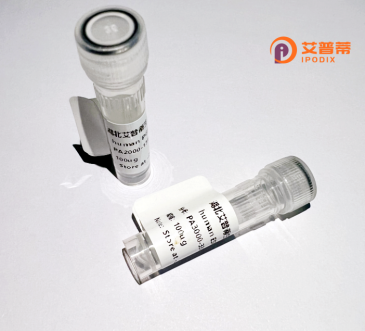
| 纯度 | >90%SDS-PAGE. |
| 种属 | Human |
| 靶点 | TRIOBP |
| Uniprot No | Q9H2D6 |
| 内毒素 | < 0.01EU/μg |
| 表达宿主 | E.coli |
| 表达区间 | 1-372 aa |
| 活性数据 | MTPDLLNFKKGWMSILDEPGEPPSPSLTTTSTSQWKKHWFVLTDSSLKYYRDSTAEEADELDGEIDLRSCTDVTEYAVQRNYGFQIHTKDAVYTLSAMTSGIRRNWIEALRKTVRPTSAPDVTKLSDSNKENALHSYSTQKGPLKAGEQRAGSEVISRGGPRKADGQRQALDYVELSPLTQASPQRARTPARTPDRLAKQEELERDLAQRSEERRKWFEATDSRTPEVPAGEGPRRGLGAPLTEDQQNRLSEEIEKKWQELEKLPLRENKRVPLTALLNQSRGERRGPPSDGHEALEKEVQALRAQLEAWRLQGEAPQSALRSQEDGHIPPGYISQLVGVITVPVLQTRPLSSERLCDLPKVTPPAGLKGGI |
| 分子量 | 67.32 kDa |
| 蛋白标签 | GST-tag at N-terminal |
| 缓冲液 | PBS, pH7.4, containing 0.01% SKL, 1mM DTT, 5% Trehalose and Proclin300. |
| 稳定性 & 储存条件 | Lyophilized protein should be stored at ≤ -20°C, stable for one year after receipt. Reconstituted protein solution can be stored at 2-8°C for 2-7 days. Aliquots of reconstituted samples are stable at ≤ -20°C for 3 months. |
| 复溶 | Always centrifuge tubes before opening.Do not mix by vortex or pipetting. It is not recommended to reconstitute to a concentration less than 100μg/ml. Dissolve the lyophilized protein in distilled water. Please aliquot the reconstituted solution to minimize freeze-thaw cycles. |
以下是关于重组人TRIOBP蛋白的3篇经典参考文献的简要概括:
1. **"Mutations in TRIOBP, which encodes a putative cytoskeletal-organizing protein, are associated with autosomal recessive nonsyndromic deafness"**
- **作者**: Riazuddin et al.
- **摘要**: 该研究首次发现TRIOBP基因突变与常染色体隐性遗传非综合征性耳聋相关。通过功能分析表明,TRIOBP蛋白通过调控肌动蛋白细胞骨架的组织,影响耳蜗毛细胞静纤毛结构的完整性,突变会导致毛细胞功能障碍和听力丧失。
2. **"TRIOBP-1 maintains auditory hair cell function by organizing the actin meshwork of stereocilia"**
- **作者**: Kitajiri et al.
- **摘要**: 本研究发现TRIOBP-1异构体在听觉毛细胞的静纤毛中高表达,通过形成独特的肌动蛋白交叉连接结构维持静纤毛的机械敏感性。基因敲除实验表明,TRIOBP-1缺失导致肌动蛋白束解体,进而引发耳聋。
3. **"Distinct expression and function of TRIOBP-1 and TRIOBP-2 isoforms in the cochlea"**
- **作者**: Riazuddin et al.
- **摘要**: 研究揭示了TRIOBP两种主要异构体(TRIOBP-1和TRIOBP-2)的差异表达:TRIOBP-1特异性表达于毛细胞静纤毛,参与肌动蛋白组织;而TRIOBP-2广泛表达于耳蜗支持细胞,可能在细胞间连接中发挥作用,两者协同保障听觉功能。
---
以上文献均聚焦于TRIOBP在听觉系统中的关键作用,涵盖疾病关联、细胞骨架调控及异构体功能差异等方向。如需更近期研究(如与神经系统疾病或癌症的关联),建议通过PubMed或Google Scholar以“TRIOBP protein”和“年份>2020”为关键词检索。
TRIOBP (Trio- and F-actin-Binding Protein) is a cytoskeleton-associated protein crucial for maintaining structural integrity in various tissues, particularly in the inner ear. Encoded by the *TRIOBP* gene on human chromosome 22q13. it exists in multiple splice variants, with TRIOBP-1 (short isoform) and TRIOBP-4 (long isoform) being the most studied. TRIOBP-4 is predominantly expressed in the cochlea, where it stabilizes F-actin bundles within the stereocilia of hair cells, essential for sound transduction. Mutations in *TRIOBP* are linked to autosomal recessive nonsyndromic hearing loss (DFNB28), highlighting its role in auditory function.
Structurally, TRIOBP contains coiled-coil domains and actin-binding regions, enabling it to act as a scaffold for cytoskeletal organization. Beyond the auditory system, TRIOBP interacts with signaling molecules like TRIO, influencing cell adhesion, migration, and neural development. Emerging studies suggest its involvement in neuropsychiatric disorders, including schizophrenia, though mechanisms remain unclear.
Recombinant TRIOBP proteins are used to investigate its molecular interactions, dissect mutation impacts, and model hearing-related pathologies *in vitro*. Research tools include overexpression systems and knockouts to explore its dual roles in cytoskeletal dynamics and disease pathways, offering potential for therapeutic targeting in hearing disorders and beyond.
×